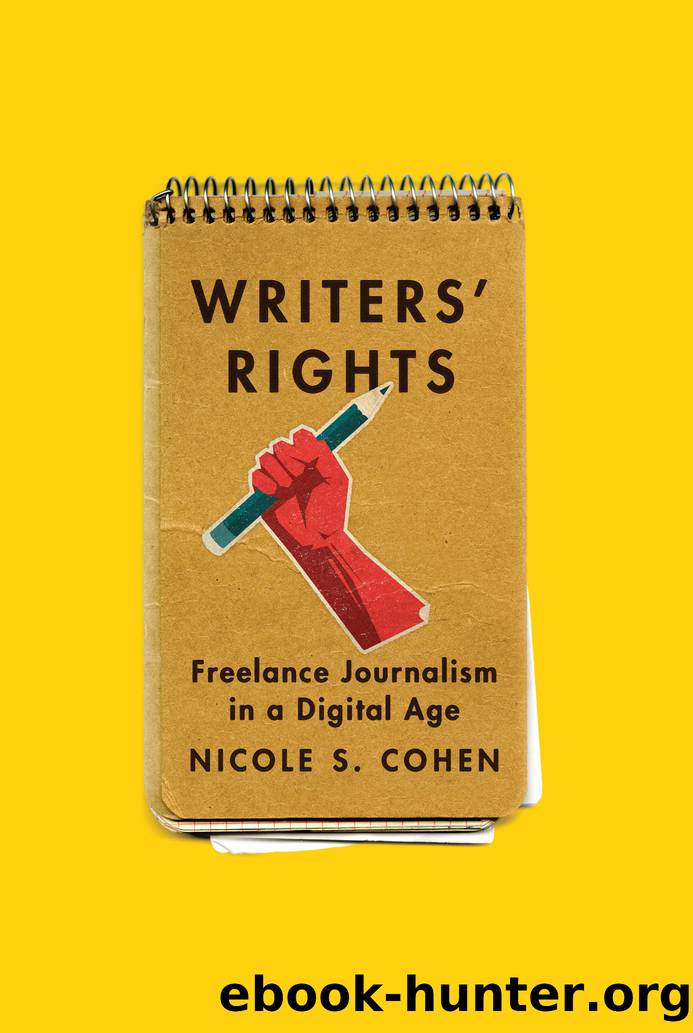Writers' Rights by Nicole S. Cohen

Author:Nicole S. Cohen
Language: eng
Format: epub
Publisher: MQUP
Published: 2016-09-15T00:00:00+00:00
MAKING FREELANCE LABOUR VISIBLE ONLINE
It seems, in the words of one writer, that âcapitalism is kicking journalistsâ assesâ (Wong 2014). Indeed, the story I have told thus far shows a bleak picture for freelancers working in digital media. For most, the Internet has not fulfilled its promise as a land of boundless opportunity and easy money. Rather, digital publishing models that demand much more for much less are the result of media capitalistsâ strategic use of technology to â[strip] labour costs to the boneâ (Ross 2009b). And so digital journalism is marked by low pay, no pay, and deepening commodification, fuelled by a deep power imbalance between individual writers and the companies for which they work. Yet, while media capitalists use the Internet to devalue the work of writing, freelancers use the same tools to publicize, address, and try to improve their conditions. For many, this comes in the form of the first-person accounts of work experiences Iâve examined in this chapter, individual efforts to make visible payments and treatment by publishers. In one notable experiment, Dieker posts her weekly earnings from freelance writing on her blog for all to see (hello-the-future.tumblr.com). In 2014, she earned US$40,966.48 from freelance writing, producing about twenty articles per week, and in 2015 she increased her earnings to US$63,571.12, which she did by âhustling for moreâ work when she didnât meet her monthly income target, looking for a higher-paying client every three months, sending out a new pitch every week, and working longer hours (Dieker 2015, 2016). Dieker is positive about her work and publicizes her experiences as a form of knowledge sharing with other freelancers. Making her earnings visible throws into relief the value and devaluing of freelance labour.
Less established writers are not as willing to attach their names to their complaints and so participate in anonymous collective expressions of dissent through blogs, tweets, and tumblrs, including Who Pays Writers? Cobbling together information on publicationsâ often-opaque payment schemes is a way to challenge their power and make use of the Internetâs capacity for anonymity and transparency. As Martin notes, secrecy about payment rates only benefits those who sign the cheques (Who Organizes Writers? panel 2014). Another freelancer wants to see this project pushed further, with freelancers scanning and uploading contracts to compare publishersâ practices and creating a form of âstandards setting.â Freelancer Scott Carney launched a similar project, WordRates, as a Google document that anyone could access to input rates paid by US newspapers and magazines. Carney ran a Kickstarter campaign in 2015 to turn the spreadsheet into a stand-alone website to enable freelancers to upload and compare contracts and to rate editors and publications for which they write. âJust comparing rates and contract terms between publications will give writers the power to take control of their financial future instead of just being subject to whatever the whims are of the particular publication theyâre working with,â Carney says. âI hope thereâs a cultural shift because of thisâ (cited in Sanders 2015a). Visibility projects
Download
This site does not store any files on its server. We only index and link to content provided by other sites. Please contact the content providers to delete copyright contents if any and email us, we'll remove relevant links or contents immediately.
You Don't Own Me by Orly Lobel(1405)
Intellectual Property Strategy by John Palfrey(1385)
Hello, My Name is Awesome by Alexandra Watkins(1324)
Without Copyrights by Spoo Robert(1309)
Profit From Your Idea: How to Make Smart Licensing Deals by Attorney Richard Stim(1296)
The Trademark Guide by Lee Wilson(1200)
Democracy of Sound by Alex Sayf Cummings(1185)
A Triumph of Genius: Edwin Land, Polaroid, and the Kodak Patent War by Ronald K. Fierstein(1169)
The Copywriter's Handbook by Robert W. Bly(1134)
Kafka's Last Trial by Benjamin Balint(1133)
World War 3.0 by Ken Auletta(1121)
Data Protection: A Practical Guide to UK and EU Law by Carey Peter(1106)
What They'll Never Tell You About the Music Business by Peter M. Thall(1064)
BVR's Guide to Intellectual Property Valuation by Michael Pellegrino(1049)
The Tech Contracts Handbook: Software Licenses and Technology Services Agreements for Lawyers and Businesspeople by David Tollen(1046)
Mass Media Law by Pember Don & Pember Don(1040)
Hello, My Name Is Awesome: How to Create Brand Names That Stick (BK Business) by Alexandra Watkins(1032)
Patent It Yourself: Your Step-by-Step Guide to Filing at the U.S. Patent Office by Pressman David Attorney(1030)
The New Censorship: Inside the Global Battle for Media Freedom by Joel Simon(1013)
